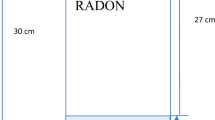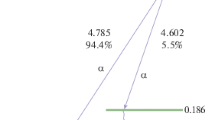Abstract
Environmental radon emanates from the exhalation and release of soil, rocks, and building materials. Environmental radon contamination tracing and radon pollution prevention and control require the measurement of the radon exhalation rate on media surfaces. Reliable measurements of the radon exhalation rate cannot be achieved without regular calibration of the measuring instrument with a high-performance reference device. In this study, a reference device for the calibration of radon exhalation rate measuring instruments was developed using a diffusion solid radon source with a high and stable radon emanation coefficient, an integrated diffusion component composed of a plasterboard and a high-density wooden board, an air pressure balance device, a radon accumulation chamber, and a support structure. The uniformity and stability of the reference device were evaluated using the activated carbon-γ spectrum and open-loop method, respectively, to measure the radon exhalation rate. The reference device achieved different radon exhalation rates by using different activities of diffusion solid radon sources. Nineteen measurement points were regularly selected on the radon exhalation surface of the reference device, and the uniformity of the radon exhalation rate exceeded 5%. The short-term stability of the reference device was better than 5% under different environmental conditions and was almost unaffected by the ambient air pressure, environmental temperature, and relative humidity.









Similar content being viewed by others
Data availability
The data that support the findings of this study are openly available in Science Data Bank at https://doi.org/10.57760/sciencedb.j00186.00136 and https://cstr.cn/31253.11.sciencedb.j00186.00136.
References
N. Lavi, V. Steiner, Z.B. Alfassi, Measurement of radon emanation in construction materials. Radiat. Meas. 44(4), 396–400 (2009). https://doi.org/10.1016/j.radmeas.2009.04.009
United Nations Scientific Committee on the Effects of Atomic Radiation. Effects of Ionizing Radiation, United Nations Scientific Committee on the Effects of Atomic Radiation (UNSCEAR) 2006 Report, Volume I: Report to the General Assembly, Scientific Annexes A and B. United Nations, 2008. https://doi.org/10.18356/7fb405cb-en
D.-K. Ting, WHO handbook on indoor radon: a public health perspective. Int. J. Environ. Stud. 67(1), 100–102 (2010). https://doi.org/10.1080/00207230903556771
Y. Huo, P. Xu, C. Zhou et al., Effect of environment humidity to radon measurement with SSNTD. Nucl. Sci. Tech. 20(4), 228–230 (2009). https://doi.org/10.13538/j.1001-8042/nst.20.228-230
J. Somlai, Z. Gorjánácz, A. Várhegyi et al., Radon concentration in houses over a closed Hungarian uranium mine. Sci. Total Environ. 367(2–3), 653–665 (2006)
J. Jónás, J. Somlai, E. Tóth-Bodrogi et al., Study of a remediated coal ash depository from a radiological perspective. J. Environ. Radioactiv. 173, 75–84 (2017). https://doi.org/10.1016/j.jenvrad.2016.11.010
X.J. Li, S.K. Qiu, C.K. Liu, A calibration facility for radon fluxmeter. Radiat. Prot. 28(4), 197–201 (2008). (in Chinese)
S. Röttger, A. Röttger, C. Grossi et al., Radon metrology for use in climate change observation and radiation protection at the environmental level. Adv. Geosci. 57, 37–47 (2022). https://doi.org/10.5194/adgeo-57-37-2022
P.Y. Wang, Y.F. Jia, Reduce indoor pollution and share fresh air—interpretation of GB 50325–2020 “Standard for door Environmental Pollution Control of Civil Building Engineering.” Constr. Qual. 39(03), 1–5 (2021). (in Chinese)
L.D. Lv, Z.Z. He, S.K. Qiu et al., Evaluation and measurement methods for the surface radon exhalation rate of buildings. Indoor Built Environ. 31(10), 2378–2385 (2022). https://doi.org/10.1177/1420326X221109754
Y.F. Yang, L.D. Lv, S.K. Qiu et al., Study on the influence of sampling methods for measuring soil radon exhalation rates. Radiat. Meas. 159, 106880 (2022). https://doi.org/10.1016/j.radmeas.2022.106880
GB/T(Chinese Standards) GB/T 16143-1995. Charcoal canister method for measuring 222Rn exhalation rate from building surface (English Vision). Beijing: National Health Commission of the People’s Republic of China, 1995.
Y.L. Tan, D.T. Xiao, H. Yuan et al., Revision for measuring radon exhalation rate in open loop. J. Instrum. 8(01), T01004 (2013). https://doi.org/10.1088/1748-0221/8/01/T01004
J.N. Hartley, G.W. Gee, E.G. Baker, et al., 1981 Radon barrier field test at Grand Junction uranium mill tailings pile. Pacific Northwest Lab. Richland, WA (USA), 1983. https://www.osti.gov/biblio/6405607
R. Collé, J.M.R. Hutchinson, M.P. Unterweger, The NIST primary radon-222 measurement system. J. Res. Natl. Inst. Stan. 95(2), 155 (1990). https://doi.org/10.6028/jres.095.018
L.D. Lv, X.P. Qiu, S.K. Qiu et al., Study of active carbon measuring method for accurate measurements of radon exhalation rates for building materials. J. Univ. South China (Sci. Technol.) 28(01), 9–12 (2014). https://doi.org/10.19431/j.cnki.1673-0062.2014.01.004 (in Chinese)
A. Tsapalov, K. Kovler, P. Miklyav, Open charcoal chamber method for mass measurements of radon exhalation rate from soil surface. J. Environ. Radioactiv. 160, 28–35 (2016). https://doi.org/10.1016/j.jenvrad.2016.04.016
X.S. Liu, S.K. Qiu, A rapid and accurate method for measuring radon exhalation rate. Radiat. Prot. 27(03), 156–162 (2007). https://doi.org/10.3321/j.issn:1000-8187.2007.03.005 (in Chinese)
Q. Tang, S.K. Qiu, D.T. Xiao et al., Extraction and purification of 227Ac and development of solid 219Rn source. Radiochim. Acta 102(1–2), 169–174 (2014). https://doi.org/10.1515/ract-2014-2117
J. Ke, Y.L. Ke, Y.H. Zhuang et al., The analysis of the performance in the calibration of radon measurement instrument by several kinds of solid standard source. South China J. Seismol. 35(2), 43–49 (2015). https://doi.org/10.13512/j.hndz.2015.02.007 (in Chinese)
W.Y. Du, GD—L2 Flow-type solid radon source calibration factors of radon measurement instrument and its influence. J. Inst. Disaster Prev. 15(3), 67–71 (2013). https://doi.org/10.3969/j.issn.1673-8047.2013.03.012 (in Chinese)
E. Saleh, A.M.A. Al-Sobahi, S.A.E. El-Fiki, Assessment of radon exhalation rate, radon concentration and annual effective dose of some building materials samples used in Yemen. Acta Geophys. 69(4), 1325–1333 (2021). https://doi.org/10.1007/s11600-021-00628-z
M. Noguchi, H. Wakita, A method for continuous measurement of radon in groundwater for earthquake prediction. J. Geophys. Res. 82(8), 1353–1357 (1977). https://doi.org/10.1029/JB082i008p01353
H.N.P. Thu, N. Van Thang, L.C. Hao, The effects of some soil characteristics on radon emanation and diffusion. J. Environ. Radioactiv. 216, 106189 (2020). https://doi.org/10.1016/j.jenvrad.2020.106189
C. Miró, E. Andrade, M. Reis et al., Development of a couple of methods for measuring radon exhalation from building materials commonly used in the Iberian Peninsula. Radiat. Prot. Dosim. 160(1–3), 177–180 (2014). https://doi.org/10.1093/rpd/ncu063
Z.Q. Li, D.T. Xiao, G.Z. Zhao et al., Rapid determination of radon monitor’s calibration factors. Nucl. Sci. Tech. 27, 116 (2016). https://doi.org/10.1007/s41365-016-0118-2
P. Tuccimei, M. Moroni, D. Norcia, Simultaneous determination of 222Rn and 220Rn exhalation rates from building materials used in Central Italy with accumulation chambers and a continuous solid state alpha detector: influence of particle size, humidity and precursors concentration. Appl. Radiat. Isot. 64(2), 254–263 (2006). https://doi.org/10.1016/j.apradiso.2005.07.016
G.P. Xiao, D.T. Xiao, L.D. Lv et al., Study on active carbon sampling device for measuring radon exhalation rate. Nucl. Electron. Detect. Technol. 35(11), 1119–1123 (2015). https://doi.org/10.3969/j.issn.0258-0934.2015.11.016 (in Chinese)
C.E. Lawrence, R.A. Akber, A. Bollhöfer et al., Radon-222 exhalation from open ground on and around a uranium mine in the wet-dry tropics. J. Environ. Radioact. 100(1), 1–8 (2009). https://doi.org/10.1016/j.jenvrad.2008.09.003
S.H. Alharbi, R.A. Akber, Radon-222 activity flux measurement using activated charcoal canisters: revisiting the methodology. J. Environ. Radioact. 129, 94–99 (2014). https://doi.org/10.1016/j.jenvrad.2013.12.021
J.L. Pinault, J.C. Baubron, Signal processing of diurnal and semidiurnal variations in radon and atmospheric pressure: a new tool for accurate in situ measurement of soil gas velocity, pressure gradient, and tortuosity. J. Geophys. Res. Solid Earth 102(B8), 18101–18120 (1997). https://doi.org/10.1029/97JB00971
Acknowledgements
We are particularly grateful to Drs. Shao-Bin Guan, Zong-Jie Zhou, Feng-Lin Li, and Tao Sun of the Chinese Nuclear Industry Remote Sensing Center for providing support under experimental conditions.
Author information
Authors and Affiliations
Contributions
All authors contributed to the study conception and design. Material preparation, data collection and analysis were performed by Wei-Gang Li, De-Tao Xiao, Zheng-Zhong He, Xiang-Yuan Deng and Shou-Kang Qiu. The first draft of the manuscript was written by Wei-Gang Li and all authors commented on previous versions of the manuscript. All authors read and approved the final manuscript.
Corresponding author
Ethics declarations
Conflict of interest
The authors declare that they have no conflict of interest.
Additional information
This work was supported by the National Natural Science Foundation of China (No.11875165).
Rights and permissions
Springer Nature or its licensor (e.g. a society or other partner) holds exclusive rights to this article under a publishing agreement with the author(s) or other rightsholder(s); author self-archiving of the accepted manuscript version of this article is solely governed by the terms of such publishing agreement and applicable law.
About this article
Cite this article
Li, WG., Xiao, DT., He, ZZ. et al. Reference device for calibration of radon exhalation rate measuring instruments and its performance. NUCL SCI TECH 34, 128 (2023). https://doi.org/10.1007/s41365-023-01275-3
Received:
Revised:
Accepted:
Published:
DOI: https://doi.org/10.1007/s41365-023-01275-3




